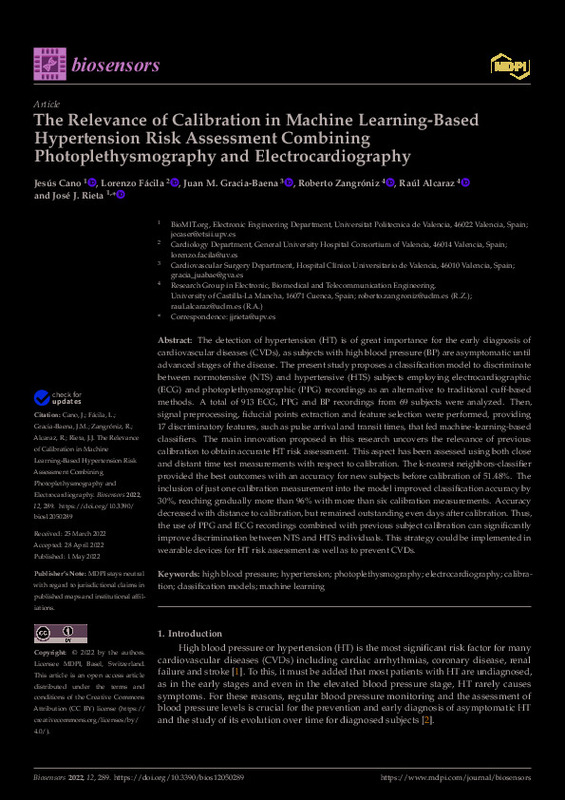JavaScript is disabled for your browser. Some features of this site may not work without it.
Buscar en RiuNet
Listar
Mi cuenta
Estadísticas
Ayuda RiuNet
Admin. UPV
The Relevance of Calibration in Machine Learning-Based Hypertension Risk Assessment Combining Photoplethysmography and Electrocardiography
Mostrar el registro sencillo del ítem
Ficheros en el ítem
| dc.contributor.author | Cano, Jesús
|
es_ES |
| dc.contributor.author | Fácila, Lorenzo
|
es_ES |
| dc.contributor.author | Gracia-Baena, Juan M.
|
es_ES |
| dc.contributor.author | Zangróniz, Roberto
|
es_ES |
| dc.contributor.author | Alcaraz, Raúl
|
es_ES |
| dc.contributor.author | Rieta, J J
|
es_ES |
| dc.date.accessioned | 2022-11-23T19:01:14Z | |
| dc.date.available | 2022-11-23T19:01:14Z | |
| dc.date.issued | 2022-05 | es_ES |
| dc.identifier.issn | 2079-6374 | es_ES |
| dc.identifier.uri | http://hdl.handle.net/10251/190113 | |
| dc.description.abstract | [EN] The detection of hypertension (HT) is of great importance for the early diagnosis of cardiovascular diseases (CVDs), as subjects with high blood pressure (BP) are asymptomatic until advanced stages of the disease. The present study proposes a classification model to discriminate between normotensive (NTS) and hypertensive (HTS) subjects employing electrocardiographic (ECG) and photoplethysmographic (PPG) recordings as an alternative to traditional cuff-based methods. A total of 913 ECG, PPG and BP recordings from 69 subjects were analyzed. Then, signal preprocessing, fiducial points extraction and feature selection were performed, providing 17 discriminatory features, such as pulse arrival and transit times, that fed machine-learning-based classifiers. The main innovation proposed in this research uncovers the relevance of previous calibration to obtain accurate HT risk assessment. This aspect has been assessed using both close and distant time test measurements with respect to calibration. The k-nearest neighbors-classifier provided the best outcomes with an accuracy for new subjects before calibration of 51.48%. The inclusion of just one calibration measurement into the model improved classification accuracy by 30%, reaching gradually more than 96% with more than six calibration measurements. Accuracy decreased with distance to calibration, but remained outstanding even days after calibration. Thus, the use of PPG and ECG recordings combined with previous subject calibration can significantly improve discrimination between NTS and HTS individuals. This strategy could be implemented in wearable devices for HT risk assessment as well as to prevent CVDs. | es_ES |
| dc.description.sponsorship | This research received financial support from grants PID2021-00X128525-IV0, PID2021123804OB-I00 and TED2021-129996B-I00 of the Spanish Government 10.13039/501100011033 jointly with the European Regional Development Fund (EU), SBPLY/17/180501/000411 from Junta de Comunidades de Castilla-La Mancha and AICO/2021/286 from Generalitat Valenciana. | es_ES |
| dc.language | Inglés | es_ES |
| dc.publisher | MDPI AG | es_ES |
| dc.relation.ispartof | Biosensors | es_ES |
| dc.rights | Reconocimiento (by) | es_ES |
| dc.subject | High blood pressure | es_ES |
| dc.subject | Hypertension | es_ES |
| dc.subject | Photoplethysmography | es_ES |
| dc.subject | Electrocardiography | es_ES |
| dc.subject | Calibration | es_ES |
| dc.subject | Classification models | es_ES |
| dc.subject | Machine learning | es_ES |
| dc.subject.classification | TECNOLOGIA ELECTRONICA | es_ES |
| dc.title | The Relevance of Calibration in Machine Learning-Based Hypertension Risk Assessment Combining Photoplethysmography and Electrocardiography | es_ES |
| dc.type | Artículo | es_ES |
| dc.identifier.doi | 10.3390/bios12050289 | es_ES |
| dc.relation.projectID | info:eu-repo/grantAgreement/AEI/Plan Estatal de Investigación Científica y Técnica y de Innovación 2013-2016/DPI2017-83952-C3-1-R/ES/ESTUDIO MULTICENTRICO PARA LA EVALUACION DEL SUSTRATO ARRITMOGENICO EN PACIENTES CON FIBRILACION AURICULAR. APLICACION A LA ABLACION POR CATETER/ | es_ES |
| dc.relation.projectID | info:eu-repo/grantAgreement/GENERALITAT VALENCIANA//AICO%2F2021%2F286//Inteligencia Artificial para Revolucionar la Medicina Móvil Usando Dispositivos Llevables/ | es_ES |
| dc.relation.projectID | info:eu-repo/grantAgreement/JCCM//SBPLY%2F17%2F180501%2F000411//Caracterización del sustrato auricular mediante análisis de señal como herramienta de asistencia procedimental en ablación por catéter de fibrilación auricular/ | es_ES |
| dc.relation.projectID | info:eu-repo/grantAgreement/AEI//PID2021-00X128525-IV0/ | es_ES |
| dc.relation.projectID | info:eu-repo/grantAgreement/AEI//TED2021-129996B-I00/ | es_ES |
| dc.relation.projectID | info:eu-repo/grantAgreement/AEI//PID2021-123804OB-I00/ | es_ES |
| dc.rights.accessRights | Abierto | es_ES |
| dc.contributor.affiliation | Universitat Politècnica de València. Escuela Politécnica Superior de Gandia - Escola Politècnica Superior de Gandia | es_ES |
| dc.description.bibliographicCitation | Cano, J.; Fácila, L.; Gracia-Baena, JM.; Zangróniz, R.; Alcaraz, R.; Rieta, JJ. (2022). The Relevance of Calibration in Machine Learning-Based Hypertension Risk Assessment Combining Photoplethysmography and Electrocardiography. Biosensors. 12(5):1-14. https://doi.org/10.3390/bios12050289 | es_ES |
| dc.description.accrualMethod | S | es_ES |
| dc.relation.publisherversion | https://doi.org/10.3390/bios12050289 | es_ES |
| dc.description.upvformatpinicio | 1 | es_ES |
| dc.description.upvformatpfin | 14 | es_ES |
| dc.type.version | info:eu-repo/semantics/publishedVersion | es_ES |
| dc.description.volume | 12 | es_ES |
| dc.description.issue | 5 | es_ES |
| dc.identifier.pmid | 35624590 | es_ES |
| dc.identifier.pmcid | PMC9138834 | es_ES |
| dc.relation.pasarela | S\463414 | es_ES |
| dc.contributor.funder | GENERALITAT VALENCIANA | es_ES |
| dc.contributor.funder | AGENCIA ESTATAL DE INVESTIGACION | es_ES |
| dc.contributor.funder | Agencia Estatal de Investigación | es_ES |
| dc.contributor.funder | European Regional Development Fund | es_ES |
| dc.contributor.funder | Junta de Comunidades de Castilla-La Mancha | es_ES |
| upv.costeAPC | 1623,08 | es_ES |








